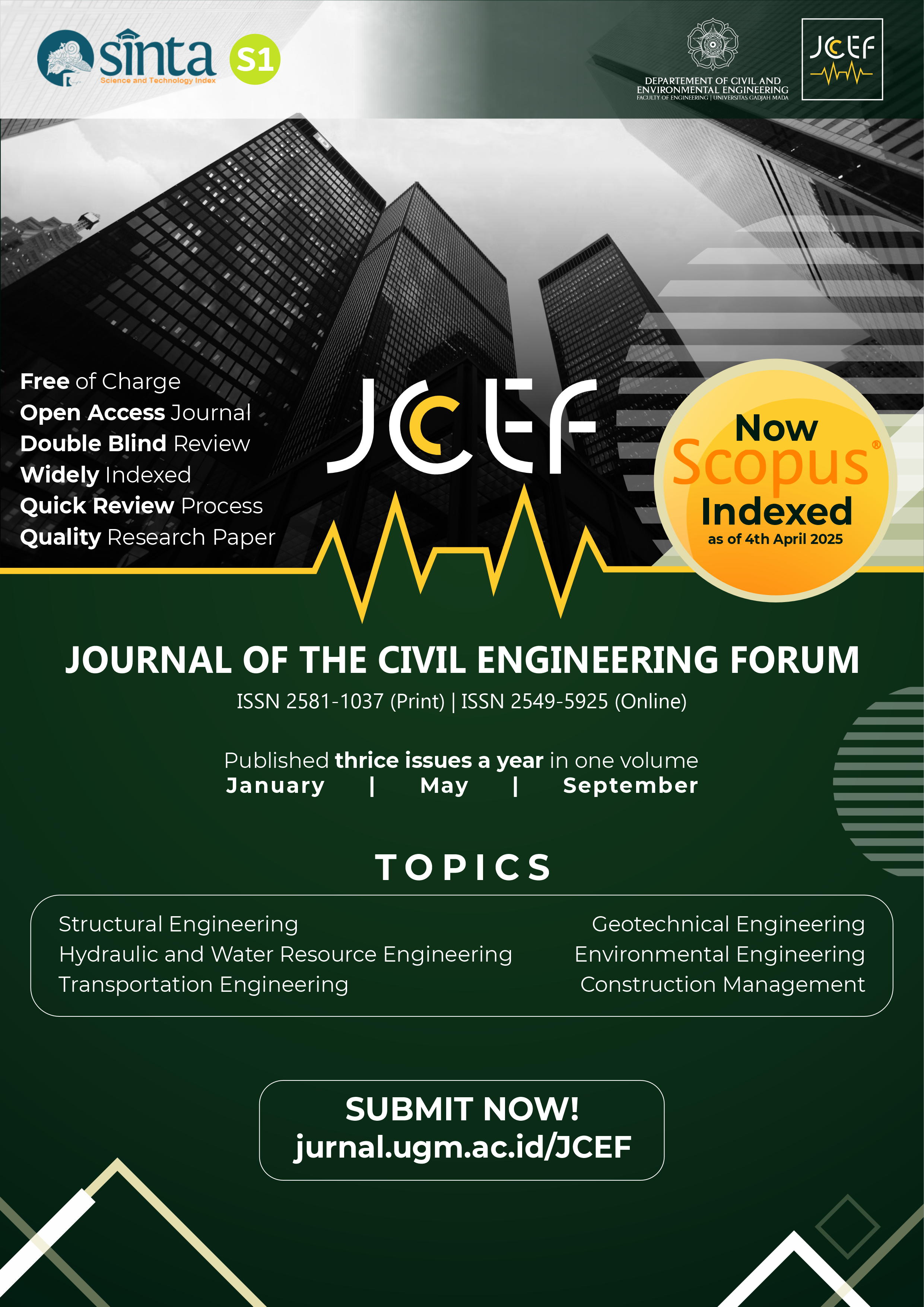Dam Break Analysis of Sermo Dam
Abstract
Sermo Dam is located in the Special Region of Yogyakarta and serves multiple purposes including providing drinking water, supplementing irrigation systems in the Kalibawang area, and flood control. According to data published by the World Commission, 60% of mitigation measures taken to overcome the impact of dam structure failures are unsuccessful. The simulation of dam failure serves as a crucial aspect of flood mitigation plans and strategies because it is more destructive than natural flood waves. This research used HEC-RAS 5.0.7 to examine the flood inundation mapping and simulate dam failure in two dimensions. However, Dam Break Analysis was adopted to provide a Dam Emergency Action Plan Guide to guide managers and the community. The overtopping scenario was adapted to model the failure of the Sermo Dam based on the frequent occurrence of heavy and extreme precipitation in the affected area. Data were analyzed using unsteady flow and PMF discharge with peak inflow discharge of 1276.6 m³/s, which result in an inundation area of 9394 hectares and a maximum flood height of 17 m. Dam failure-induced floods tend to potentially affect eight sub-districts including Kokap, Pengasih, Sentolo, Wates, Panjatan, Galur, Lendah, and Temon. The piping scenario is also considered based on the potential damage that tends to occur. In the piping scenario, the biggest flooding area was 5112 hectares with a maximum flood height of 13 m. About six sub-districts are potentially affected by dam failure-induced floods with Kokap and Sentolo being excluded from the list. Therefore, it is crucial to establish early warning systems and infrastructure to mitigate disaster risks. The results of this research can also inform evacuation planning, damage estimation, and post-flood rehabilitation efforts in the affected areas.
References
Azdan, M. D. and Samekto, C. R. (2008), Kritisnya kondisi bendungan di indonesia, in ‘Seminar Nasional Bendungan Besar Indonesia’.
Bharath, A., Shivapur, A. V., Hiremath, C. and Maddamsetty, R. (2021), ‘Dam break analysis using HEC-RAS and HEC-GEORAS: A case study of Hidkal dam, Karnataka State, India’, Environmental Challenges 5, 100401.
Brunner, G. (2016), River Analysis System, 2D Modeling User’s Manual Version 5.0, US Army Corps of Engineers, Institute for Water Resources, Hydrologic Engineering Center.
Costa, J. E. (1985), Floods from Dam Failures, Geological Survey, United States Department of the Interior, Denver.
Derdous, O., Djemili, L., Bouchened, H. and Tachi, S. E. (2015), ‘A GIS based approach for the prediction of the dam break flood hazard–a case study of Zardezas Reservoir “Skikda, Algeria”’, Journal of Water and Land Development (27), 15–20.
Director General for Water Resources (2010), ‘Government Regulation (PP) number 37, director general for water resources’, Jakarta. Accessed: May 5, 2023. URL: https://peraturan.bpk.go.id/Home/Details/46892/pp-no-37-tahun-2010
FEMA, P. (2013), 946. federal guidelines for inundation mapping of flood risk associated with dam incidents and failures, Technical report, Technical Report Federal Emergency Management Agency: Washington, DC, USA.
Fread, D. L. (1984), DAMBRK: The NWS dam-break flood forecasting model, Vol. 4, Hydrologic Research Laboratory, National Weather Service, NOAA Silver Spring.
Froehlich, D. C. (1995a), Embankment dam breach parameters revisited, in ‘Water Resources Engineering, Proceedings of the 1995 Conference on Water Resources Engineering’, s.n., San Antonio, Texas, pp. 887–891.
Froehlich, D. C. (1995b), ‘Peak outflow from breached embankment dam’, Journal of Water Resources Planning and Management 121(2), 90–97.
Froehlich, D. C. (2008), ‘Embankment dam breach parameters and their uncertainties’, Journal of Hydraulic Engineering 134(12), 1708–1721.
Initiative, N., Nile, E., Action, S. and Base, S. (2013), Final report special technical study: Dam break analysis for selected cascade of dams on the blue nile 1-49, Technical report, Unpublished report.
Istiarto, M. P. (2014), ‘Simulasi aliran 1 dimensi dengan bantuan paket program hidrodinamika HEC-RAS’, Universitas Gadjah Mada, Yogyakarta .
Khalfallah, C. B. and Saidi, S. (2018), ‘Spatiotemporal floodplain mapping and prediction using HEC-RAS-GIS tools: Case of the mejerda river, tunisia’, Journal of African Earth Sciences 142, 44–51.
Khosravi, K., Rostaminejad, M., Cooper, J. R., Mao, L. and Melesse, A. M. (2019), Dam break analysis and flood inundation mapping: The case study of sefid-roud dam, Iran, in ‘Extreme Hydrology and Climate Variability’, Elsevier, pp. 395–405.
US Army Corps of Engineers Hydrolic Engineering Center, (2014), Using HEC-RAS for Dam Break Studies. U.S. Army Corps of Engineers Institute for Water Resources Hydrologic.
Peter, S.J., 2017. Dam Break Analysis under Uncertainty, VAW-Mitteilungen 241, Versuchsanstalt für Wasserbau, Hydrologie und Glaziologie (VAW), (R. M. Boes, ed.). Schweiz, ETH Zürich.
Styawan, A. P., Rahardjo, A. P. and Sujono, J. (2018), Warning time analysis of Nasiri river flash flood due to several possible natural dam break events, in ‘Journal of the Civil Engineering Forum, Vol. 4.
Urzică, A., Mihu-Pintilie, A., Stoleriu, C. C., Cîmpianu, C. I., Huţanu, E., Pricop, C. I. and Grozavu, A. (2021),‘Using 2d HEC-RAS modeling and embankment dam break scenario for assessing the flood control capacity of a multi-reservoir system (ne romania)’, Water 13(1), 57.
Copyright (c) 2023 The Author(s)

This work is licensed under a Creative Commons Attribution-ShareAlike 4.0 International License.
Copyright is granted to authors for the purpose of providing protection for articles written to describe experiments and their results. JCEF will protect and defend the work and reputation of the author and are also willing to address any allegations of violation, plagiarism, fraud, etc. against articles written and published by JCEF. JCEF is published under the terms of the Creative Commons Attribution-ShareAlike 4.0 International License (CC BY-SA 4.0). The author holds the copyright and assigns the journal rights to the first publication (online and print) of the work simultaneously.







